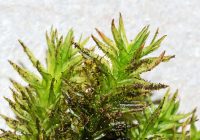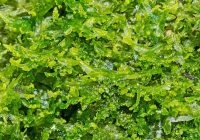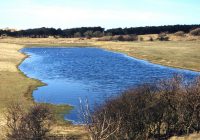Dr Phil Smith’s Wildlife Notes
January 2021
Following on from a rainy December, January was another wet month. Although it rained on only about 14 days, there were two exceptionally wet periods, from 13th-16th and 18th-20th, the latter coinciding with named storm Christophe. This storm produced the wettest 3-days in Northwest England and North Wales since records began in 1891. As a result my measuring point in the Devil’s Hole rose by an unprecedented 28.5 cm during the month, deeply flooding this slack and others along the dune coast. It was also the coldest January for ten years, though apart from a slight sprinkle one morning, Formby had no snow.
Covid-19 restrictions meant fewer trips out than usual and only those that could be justified as ‘exercise’. However, a walk down to the local shops along Whitehouse Lane was unexpectedly rewarding. I noticed a fine display of mosses on the trunk of a roadside Ash tree. One looked unfamiliar, so I took a small sample to check at home. It was Lyell’s Bristle–moss Orthotrichum lyellii, easily identified by the dusting of tiny brown gemmae (spore-bearing structures) on the leaves. Distribution maps show records in Southport and Liverpool but it was the first for Formby. Found on a variety of trees, including Ash, this moss was eliminated from large areas of the county by sulphur pollution but is now returning.
A walk around Sands Lake at Ainsdale was similarly profitable. Luxuriant mosses and liverworts on some of the old Alders justified close-up photographs that revealed another new species for me, Whiskered Veilwort Metzgeria consanguinea. As there are other similar liverworts, I had to send photos to the vice-county recorder for confirmation. Des Callaghan found the first for the Sefton Coast as recently as last November; mine was the second. This species has also been spreading through Britain in recent decades, though the 2014 Bryophyte Atlas shows no coastal records in Northwest England. Sands Lake itself was rather disappointing. Only about 20 Tufted Ducks, 12 Gadwall, five Shovelers, a Little Grebe, together with the resident pair of Mute Swans and two of last year’s young, joined the usual semi-tame Mallards. I checked through about 80 Black-headed Gulls but no other gull species was hiding amongst them. The nearby Green Beach slacks were well flooded, as expected, but large numbers of people and dogs on the shore meant that searching for Snow Buntings or other birds was not likely to be fruitful. In fact I have never seen so much public pressure on the dunes in mid-winter, several of my informants also reporting churned up and widened footpaths and increasing disturbance to wildlife. It was sad to see people on the usually restricted Altcar Rifle Range beach walking straight through a large high-tide wader roost, completely oblivious to the resting birds, many of which have flown thousands of miles to get here.
A stroll around Cabin Hill National Nature Reserve revealed the extent of flooding in the large borrow-pits created when a barrier bank was constructed in 1970/71. Comparing my photos with 35mm colour-slides of similar high water-levels in 1981 and 1995 showed how the landscape has changed. Forty years ago, the vegetation was grazed short by a combination of abundant Rabbits and livestock. There was hardly any scrub and the high dunes to the north had lots of bare sand. The Rabbits are long gone and, despite the efforts of Cumbrian Herdwick Sheep in winter, rank vegetation and scrub prevail, while nearby dune crests are largely overgrown. The reserve managers are doing a great job trying to reverse these trends by mowing areas of tall grassland, cutting scrub and creating sandy scrapes but it’s a daunting battle. As I walked on to Cabin Hill Wood, a Great Tit was proclaiming its territory with its ‘teacher, teacher’ song, two Buzzards flew into the edge of the wood, as did about 50 Linnets, the males singing their heads off. Another harbinger of spring was the low double coo of a Stock Dove, while five non-native Pheasants busting from cover with strident calls were less welcome. The usual display of flowering Snowdrops had hardly got going but a complete surprise was a small Hebe bush near the path. There was no evidence it had been planted; several species are known to escape from gardens and become established in the wild but I won’t be able to identify it until it flowers. Finally, a nearby dead branch supported typical fruiting bodies of the Jelly-ear fungus Auricularia auricula-judae.
However, these sightings pale into insignificance compared with Ian Wolfenden’s Reindeer on the sand-flats of the Alt Estuary on 2nd January. It was distant but unmistakable through his telescope. This would be the first for Merseyside for about 1000 years! The last British Reindeer were hunted to extinction in Scotland about 800 years ago. Of course, it wasn’t a wild one; it escaped from a Christmas ‘grotto’, took up residence on the Rifle Range, was eventually tranquilised by a vet and returned to its home in Wales.






